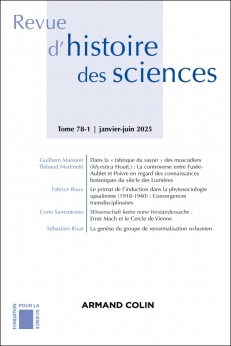
REVUE D'HISTOIRE DES SCIENCES (1/2025)
Pour acheter ce numéro, contactez-nous
Recevez les numéros de l'année en cours et accédez à l'intégralité des articles en ligne.
En 1755, le rêve de l’ex-missionnaire Pierre Poivre (1719-1786) de transformer la colonie de l’île de France en comptoir d’épices fines est brisé par l’autorité scientifique locale, l’apothicaire-botaniste Jean-Baptiste Christophe Fusée-Aublet (1723-1778). Dans une série de rapports, ce dernier contredit violemment la validité des récoltes de muscadiers rapportés des Indes orientales par Poivre et dénonce ouvertement une fraude. La dimension rhétorique de cette controverse botanique a été récemment analysée qui laisse au second plan la question de l’identité véritable des spécimens en question. Cependant, le débat entre Poivre et Fusée-Aublet suppose qu’une détermination précise du muscadier (Myristica fragrans Houtt.) était possible au siècle des Lumières. Dans cet article, nous établissons dans un premier temps le portrait d’une plante dont on connaissait les parties actives (graine et macis), mais dont l’identité botanique n’est encore que fragmentaire au xviiie siècle. Nous proposons ensuite, par une analyse des « indices botaniques » détectés au sein de divers manuscrits, un inventaire quantitatif et qualitatif du matériel végétal ramené lors des diverses expéditions de Poivre (1753, 1755). Nous examinons enfin la méthodologie mise en oeuvre pour la détermination de cette espèce végétale à très haute valeur économique et mettons en évidence les nombreux obstacles – factuels ou épistémiques – qui ont entravé le savoir botanique des Lumières.
In 1755, ex-missionary Pierre Poivre’s (1719-1786) dream of transforming the colony of Mauritius into a fine spice trading post was shattered by the local scientific authority, apothecary-botanist Jean-Baptiste Christophe Fusée-Aublet (1723-1778). In a series of reports, Fusée-Aublet violently contradicted the value of the nutmeg harvests brought back from the East Indies by Poivre and openly denounced it as a case of fraud. The rhetorical dimension of this botanical controversy has recently been analysed, leaving in the background the question of the true identity of the specimens in question. However, the debate between Poivre and Fusée-Aublet implies that a precise determination of the nutmeg tree ( Myristica fragrans Houtt.) was possible in the Age of Enlightenment. In this article, we first describe a plant whose active parts (seed and mace) were known, but whose botanical identity was still only fragmentary in the 18th century. We then propose a quantitative and qualitative inventory of the plant material brought back during Poivre’s various expeditions (1753, 1755), based on an analysis of the “botanical clues” found in various manuscripts. Finally, we examine the methodology used to determine this plant species of very high economic value, and highlight the many obstacles – both factual and epistemic – that hampered Enlightenment botanical knowledge.